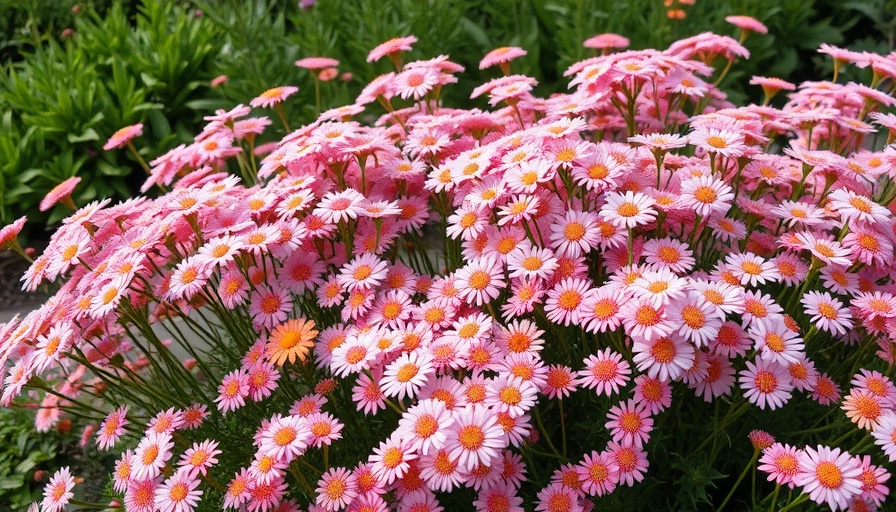
Discover the Wonders of Yarrow for Your Home Garden
Yarrow (Achillea) is not just another vibrant flower trying to steal the limelight in your garden; it is a hardworking perennial deserving of recognition for its resilience and versatility. Thriving in both poor soils and dry conditions, yarrow provides a splash of color where traditional blooms often struggle. It is a wise choice for gardeners who wish to enhance their outdoor space without excessive maintenance, making it ideal for those exploring gardening tips with an eye toward sustainability.
Yarrow: A Hardy Companion for Every Garden
One of yarrow's most remarkable traits is its adaptability to varying climatic conditions. Ideal for USDA Hardiness Zones 3 to 9, it has shown success in areas as diverse as Zone 2 and Zone 10. This hardiness allows it to join other resilient plants in flower gardens, bringing life to barren patches and underutilized spaces.
Planting yarrow is a breeze. Start flowers by sowing seeds directly into well-draining soil or cultivating mature plants in raised garden beds. Gardeners can expect blooms as early as the second year if sown conventionally, while starting seeds indoors in late winter can yield flowers even sooner. With a proven track record of draught resistance, yarrow is the perfect choice for the environmentally conscious gardener.
Top 13 Yarrow Varieties to Transform Your Garden
Here are 13 of the most stunning and useful yarrow varieties you should consider for your garden:
- Apple Blossom - Showcasing stunning pink blooms.
- Cerise Queen - Vibrant cerise flowers that attract pollinators.
- Common Yarrow - The classic choice with traditional white blooms.
- Gold - Bright yellow flowers that add warmth to your garden landscape.
- Gold Plate - With somewhat flat blooms, a unique addition.
- King Edward - A regal choice with stunning hues.
- Moonshine - Known for its silvery leaves and pale yellow blooms.
- New Vintage Rose - Offers beautiful rose-colored flowers.
- Paprika - Brilliant hues that bring a zing to any arrangement.
- Red - A deep red choice that stands out beautifully.
- Strawberry Seduction - Features raspberry-colored clusters.
- Summer Berries - Unique for its blend of colors.
- Sunny Seduction - Bright, sunny blooms that uplift any garden.
The Virtues of Growing Yarrow
Yarrow is renowned not only for its stunning aesthetic appeal but also for its remarkable pest and disease resistance. This makes it a favorite amongst gardeners looking to practice organic gardening and minimize the use of harsh chemicals. It’s drought-adaptive, making it a key player in backyard landscaping projects designed with conservation in mind.
Care Tips for the Thriving Yarrow Plant
To keep your yarrow plants at their best, grow them in full sunlight with average to poor soil that provides excellent drainage. While they flourish naturally, excessive enrichment can lead to 'leggy' growth—stems stretched and in need of support. Prudent garden maintenance involves pruning in spring to maintain a compact form and vibrant blooms.
Divide these vigorous growers every few years to prevent overcrowding. Also, their ability to spread through rhizomes makes them low-maintenance companions, as they are less likely to attract common garden pests like rabbits and deer.
Future of Your Yarrow Garden
With yarrow, a beautiful garden doesn't have to come at the cost of the environment. This multifaceted plant provides not only beauty but a palette of choices for various landscaping ideas. Whether you aim for a bursting flower bed or wish to design a unique garden pathway, the application of yarrow can enhance the aesthetic while encouraging a healthy ecosystem at home.
Why Choose Yarrow? The Emotional Connection to Gardening
Every plant you introduce to your garden tells a story. Yarrow embodies resilience and beauty, mirroring the journey of every gardener. You not only cultivate plants but also nurture your well-being through gardening—a profound connection between humans and nature.
Embrace the charm and adaptability of yarrow in your next gardening project. Explore the varieties mentioned, and experience firsthand the benefits these beauties can bring to your landscape.
As you embark on creating your ideal garden dream, bear in mind that yarrow and its companions can thrive with less care, allowing you to enjoy more of nature's splendor without the stress.
 Add Row
Add Row  Add
Add 




Write A Comment